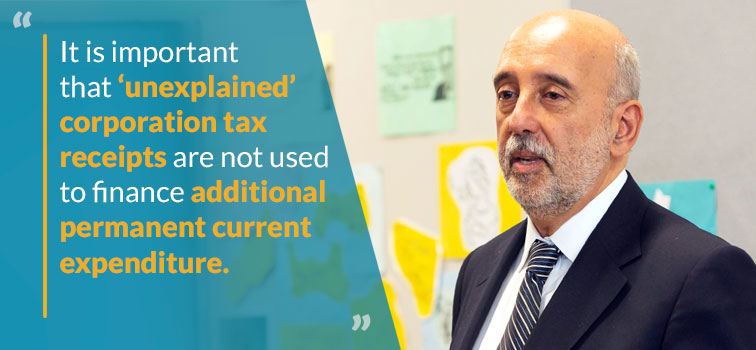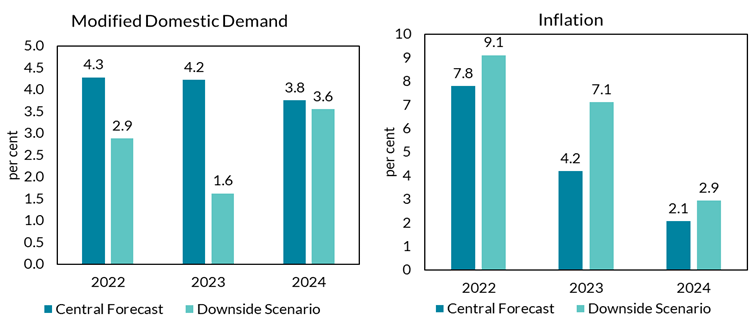Fiscal policy and planning for resilience
25 July 2022
Blog

At last week’s meeting of the ECB’s Governing Council, we decided to increase our main policy rate by 50 basis points. This continues the normalisation of our monetary policy, a path that we had started to travel on last December. Our
aim is to dampen the inflationary pressures that we’re seeing in the euro area and achieve our target of two per cent inflation over the medium term. We are acutely aware of the hardships that current high price increases cause and are determined
to ensure the benefits of price stability for households, businesses and the wider economy are realised.
Although last week’s decision was a continuation of a process that started last year, it was also significant in that it was the first time in 11 years that the ECB decided to raise its interest rates (albeit to 0 per cent). While considering the
evidence and the issues that we had to address last week, I also reflected on the developments in the economy over the last decade and what the economic environment was likely to be like in a decade’s time. The short answer of course is that
forecasting three years ahead is difficult enough, so ten years would involve very large degrees of uncertainty! On the other hand, we can also say with some certainty that some things will be different, not least because of the pace of digitilisation,
the commitment to net zero and the ageing of our societies (all of them significant economic transitions). Notwithstanding the difficulty in forecasting, it has always seemed to me that we needed to spend more time thinking about, understanding
and planning for the longer-term, intergenerational, aspects of economic policy-making (a topic I’ve written about before).
Having used a recent blog to discuss the interplay between monetary policy and macroprudential policy (and how financial stability is a pre-condition for price stability, and vice versa), today I want to outline what the current period of uncertainty
means for longer-term revenue and spending, i.e., fiscal policy.
In setting a course for the public finances over the coming years, public policy faces a difficult balancing act between the need to respond to short-run pressures while taking steps to build a more resilient economy in the face of the medium-to-longer
term economic transitions.
Latest economic outlook
The international economic outlook has deteriorated over recent months. The global inflationary shock has eroded the purchasing power of disposable incomes and increases in production costs. Euro area inflation has continued to rise and has reached
undesirably high levels. In June headline inflation rose to 8.6 per cent. Stripping out the more volatile components, ‘core’ inflation was 3.7 per cent suggesting that initial price pressures in energy and commodities have spilled
over into many of the everyday goods and services we consume.
In Ireland, and as outlined in our latest Quarterly Bulletin (QB), the evidence suggests that economic activity has weakened as the year has progressed, tempering the strong post-pandemic recovery that had been underway. High inflation and heightened
uncertainty are reducing consumer and business confidence with signs that this is having a negative effect on spending by households and firms. Projections for growth in domestic economic activity remain positive but have been revised down relative
to what we were expecting previously.
Figure 1: Modified Domestic Demand and Inflation in the Central forecast and Downside Scenario (annual avarages)

Current financial market expectations are for oil prices to decline in the second half of the year and for gas prices to follow suit next year. Supply-side constraints affecting other commodities will contribute to continuing high inflation in 2023
but the central outlook is for these to dissipate gradually. But of course uncertainty over these particular assumptions and the economic outlook more generally is high and more adverse outcomes are possible. (The implications of a more
negative scenario – assuming more protracted aggression by Russia, further increases in energy prices and more persistent supply-chain problems – are set out in Figure 1 and in the QB.)
Fiscal Policy
The economy’s rapid recovery since 2021 – best seen in the increased number of people at work and the related drop in unemployment – reflects, in part, the fiscal measures introduced to counteract the negative economic impact of the
pandemic. Measures such as the Pandemic Unemployment Payment (PUP) and the Employment Wage Subsidy Scheme (EWSS) supported the incomes of households and firms and maintained important employee-firm links. These actions helped to mitigate
the risk of any permanent damage from the pandemic and facilitated a speedy recovery in economic activity.
But this response came at a substantial cost, with government expenditure on the pandemic amounting to over €27bn. Despite this, the public finances have improved quickly with a balanced budget or even a small surplus expected this year (notable
progress given a deficit of almost 9 per cent of national income (GNI*) was registered in 2020).
These developments are welcome but fiscal policy continues to face a number of challenges. First, in terms of government revenue, having increased threefold between 2014 and 2021, corporation tax receipts have continued to grow rapidly and surpass expectations.
Research by Central Bank staff suggests that €8bn – or more than half of last year’s receipts – cannot be explained by developments in the underlying economy and therefore could be considered as potentially unsustainable.
There are also large concentration risks given the very high proportion of the tax paid by a relatively small number of companies.
Developments in the Irish economy in the late 2000s underscore the risk of treating potentially transitory revenue flows as permanent receipts. In the circumstances, I think it is important that ‘unexplained’ corporation tax receipts
are not used to finance additional permanent current expenditure.
The Department of Finance has projected permanent core expenditure (excluding pandemic and other temporary spending) to be €26bn (or 30 per cent) higher in 2025 compared to 2019, partly reflecting ambitious targets for capital spending as part of
the National Development Plan.
Balancing the effective delivery of needed public investment in the current high-inflation environment will require careful management of the other parts of the government’s overall fiscal stance, i.e., current expenditure and taxation. Recent analysis
by the Central Bank shows that further stimulating economic activity with additional permanent current spending would risk creating excess demand and in the process would add to already high inflation. To guard against such an outcome, it is
important that additional increases in current spending – for example to address cost of living pressures or other needs – are targeted and temporary. Increases in permanent core expenditure should be funded by permanent revenue-raising
measures to avoid introducing a vulnerability in the public finances as well as reducing the risk of creating imbalances in the economy as a result of excess demand.
The economy in general and the government’s finances in particular have benefited from the exceptionally low interest rate environment that has prevailed over recent years. As monetary policy normalises – and the Governing Council signalled
this process would continue at future meetings – financing costs will increase. The reduction of public debt, supported by a sustainable funding base for public expenditure, should remain a key priority in the years ahead (not least because,
as interest rates rise, financial markets are more likely to increase the focus on fundamentals such as relative debt levels when pricing sovereign bonds).
Managing transitions and building resilience
Although short-term problems have a tendency to dominate policy debate, it is important to maintain a focus on medium-to-longer term priorities when addressing day-to-day issues.
Two of the transitions that I mentioned above will add to demands on government resources in the coming years.
First, changing demographic trends will result in an ageing population and an increase in demographic-sensitive spending areas such as pension and health care costs. Acting now, when the demographic structure is still relatively favourable would reduce
the overall eventual cost of adjustment.
Second, while significant investment, both public and private, will be required to ensure the delivery of Ireland’s Climate Action Plan, delaying the necessary measures would result in a more costly transition – environmentally and economically
– in the longer term.
In my view, an objective of economic policy – at EU and individual Member State (MS) level – should be to build resilience across households, businesses and the wider economy in the face of these transitions.
To meet this challenge, we must continue to focus on fundamentals. Successful economies need stable and sustainable macroeconomic frameworks and sound monetary policy that delivers low, stable and predictable inflation. Well-regulated financial
systems and well-functioning markets are prerequisites for managing the challenges that lie ahead. In the EU, the completion of Banking Union and further developing the Capital Markets Union are important next steps.
Fiscal policy has an important role to play to incentivise the achievement of longer-term objectives. In particular, establishing a framework which ensured that excess tax revenue (over and above that needed to fund sustainable growth in core expenditure)
was saved would help to create or rebuild necessary buffers. Such an approach would help to build resilience across the economy by building necessary buffers for the public finances (enabling the State to respond appropriately when negative shocks
materialise in the future) and also by facilitating necessary capital expenditure both now and in the future (so as to reduce the ultimate cost of adverse shocks when they occur). The ‘unexplained’ corporation tax receipts provide
a strong basis for identifying the revenue that could be placed into such a resilience fund.
Conclusion
The Central Bank will continue to focus on its core mandates of price stability, a stable financial system and the protection of consumers. The pace of the post-pandemic recovery in the Irish economy has shown us the effectiveness of countercyclical fiscal
policy. A priority for policy should be to rebuild the resilience of the public finances so as to ensure the State has the resources both to mitigate the effects of future economic downturns but also to deliver the progress needed to address
the economic transitions that are currently in play. A lot happened in the last decade and strengthening our economic resilience would help us manage what’s likely to happen in the next one.
Gabriel Makhlouf
Read more: